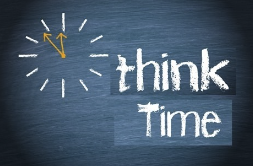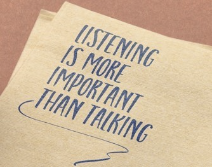Have you ever paused for a moment to collect your thoughts and had someone else jump in to fill the void of silence? This is not uncommon; people are genuinely uncomfortable with silence. We grew up with teachers always looking for the student to answer a question immediately, leaving out those needing time to think.
“Think time” is the moment between the question and the answer. If you are a contestant on Jeopardy, you can’t ponder an answer. Like many situations, such as a job interview, the expectation is rapid-fire responses. This is often interpreted as confidence and capability. But is this really the case? If you want to test people’s discomfort at your meeting, pause for as little as ten seconds and see how long before people’s body language sends a signal: why have you stopped? Are you okay? A pause in an interview is not a negative.
The silence can be deafening.
Silence makes people want to fill the void. If you anticipate someone will speak and encounter their silence, it triggers your desire to fill the void, causing the other person to lose their train of thought or feel you are disrespectful. Society has imprinted these “rules” upon us since we could talk.
 However, in interview situations, the interviewer is actually looking for the “uncomfortable silence.” When the interviewer is not speaking and the candidate pauses, they create a “holding environment.” When you hold your silence, the interviewee is forced to find words to fill the quietness. The void will lead the interviewee to explore their thoughts and feelings without interruption. The interviewee will begin to expand on their initial response. It is at that point that you have fostered a more authentic reply. At this point, most often, the pre-interview rehearsed explanation drawn from a co-worker or suggestion from the Internet disintegrates, forcing the candidate to really think about what they are saying. At this juncture, the rehearsed answer is not enough. They must draw on their own real-world experiences, attempting to talk themselves out of an answer they never believed themselves.
However, in interview situations, the interviewer is actually looking for the “uncomfortable silence.” When the interviewer is not speaking and the candidate pauses, they create a “holding environment.” When you hold your silence, the interviewee is forced to find words to fill the quietness. The void will lead the interviewee to explore their thoughts and feelings without interruption. The interviewee will begin to expand on their initial response. It is at that point that you have fostered a more authentic reply. At this point, most often, the pre-interview rehearsed explanation drawn from a co-worker or suggestion from the Internet disintegrates, forcing the candidate to really think about what they are saying. At this juncture, the rehearsed answer is not enough. They must draw on their own real-world experiences, attempting to talk themselves out of an answer they never believed themselves.
Why Silence is Powerful?
When you are in conversation, silence triggers “reflective processing.” Silence provides individuals the necessary time to reflect on the information they have just shared and process it. Does the hiring manager believe what I just said? Why are members of the panel silent to such a well-expressed story? Perhaps they feel something is left out or has not occurred. To which the candidate begins to expand on their response. Allowing for deeper thinking and can lead to more thoughtful or expanded responses. When offering additional information, the candidate iterates information they should feel they should perhaps not share. Several times, after the expanded response, I heard from the candidate, ‘Perhaps I should not have shared that much.’
Why does “Think Time” open people to ponder their response and move beyond the initial reply?
- Silence is a powerful way of communicating nonverbally, allowing the person to add to their feelings without interruption or judgment. The silence of the managers or hiring panels causes the candidate to perceive that more is wanted. The silence allows them to formulate how to expand the story in an organic and spontaneous way.
- The candidate wants to have reassurance that the interviewer is listening. Silence during a conversation demonstrates active listening and shows the candidate that they have your full attention. It allows the speaker to feel heard and understood, encouraging them to share more openly and honestly.
- Using silence strategically encourages the candidate to contribute more to the conversation. By withholding your own words, you allow the candidate to express their thoughts about their experiences as they perceive they lived them. By not adding probing questions (eg what happened next? how did others react?, how did you feel? what was the outcome?)you give them time to fill in the blanks. Often, during the added portion of their story they reveal things that will put the initial response into perspective or see the first answer fall apart.
Overall, using silence during an interview can help facilitate more meaningful and productive conversations, allowing for deeper insights and connections between the interviewer and interviewee.
Why Silence Works.
 Carl Rogers, a prominent psychologist and founder of client-centred therapy, emphasized the importance of silence. He believed silence was essential to creating an atmosphere of acceptance and understanding. According to Rogers, silence allows people to fully explore their thoughts, feelings, and experiences without interruption or judgment. It creates a safe space for people to gain insight, self-awareness, and personal growth. Rogers considered silence an opportunity for the client to take control of the therapeutic process and direct it in a way that feels most comfortable and authentic.
Carl Rogers, a prominent psychologist and founder of client-centred therapy, emphasized the importance of silence. He believed silence was essential to creating an atmosphere of acceptance and understanding. According to Rogers, silence allows people to fully explore their thoughts, feelings, and experiences without interruption or judgment. It creates a safe space for people to gain insight, self-awareness, and personal growth. Rogers considered silence an opportunity for the client to take control of the therapeutic process and direct it in a way that feels most comfortable and authentic.
It emphasizes the importance of empathy, unconditional positive regard, and genuineness in the relationship to encourage the candidate to feel comfortable and open up to give more meaningful responses. By using a non-directive approach and reflective listening and silence, the interviewer puts the candidate in the position to tap into their inner resources and provide a more robust explanation of their past experiences. Because the interviewer has not directed the answer with probing questions, the interview has established a more empathetic, safe, and accepting environment, leading to more profound and more honest responses to the candidate’s experiences and what drove them, and their values, in different situations.
The power of using silence during an interview with the interviewer lies in its ability to elicit more information, reveal more profound insights, and establish a stronger connection with the interviewee. Here are some ways in which the power of silence can be harnessed:
- Encouraging thoughtful responses: When the interviewer remains silent after a question, the interviewee can think more deeply about their response. Silence can lead to more thoughtful and authentic answers as the interviewee takes the time to formulate their thoughts before speaking.
- Promoting self-reflection: Silence allows interviewees to reflect on their experiences, thoughts, and perspectives. It may prompt them to consider different angles or provide more personal examples, resulting in deeper and more meaningful responses.
- Clarifying or expanding on answers: The interviewer allows the interviewee to elaborate on their initial response further by staying silent. Often, interviewees will feel compelled to fill the silence with additional information or clarification, providing the interviewer with a more comprehensive understanding of the topic or their perspective.
 Building rapport and trust: Using silence respectfully and attentively during an interview conveys active listening and genuine interest. This can foster rapport and trust between the interviewer and the interviewee, as the interviewee feels heard and understood.
Building rapport and trust: Using silence respectfully and attentively during an interview conveys active listening and genuine interest. This can foster rapport and trust between the interviewer and the interviewee, as the interviewee feels heard and understood.- Uncovering hidden information: Silence can be uncomfortable for some individuals, leading them to share information they may have initially held back. People often feel the need to fill silence, and in doing so, they may reveal additional insights, facts, or perspectives that they had not intended to disclose.
- Allowing the interviewee to take the lead: Silence enables the interviewee to control and direct the conversation. By remaining silent, the interviewer allows the interviewee to delve deeper into topics that matter to them, offering valuable insights that may not have been uncovered otherwise.
- Sharing what matters most: By allowing the candidate to take the lead, you also allow them to define what is important. You will enable them to share their motivations and perhaps the values they hold that are the source of their motivation.
The most impactful time for silence is when the candidate responds with a yes, no, please repeat the question or another ambiguous, meaningless response. At this point,’ think time’ is powerful. Silence will force the candidate to move beyond the empty response. To elicit and expand beyond the meaningless response, try the simple words “and” or “why” and count to 30 seconds. For the candidate, the ‘pregnant pause’ is deafening. They will fill the void.
Overall, the power of using silence in an interview lies in its ability to enhance the depth and quality of the conversation, foster authenticity, and trust, and eliciting valuable information and insights from the interviewee that they did not intend to share. By using silence, the candidate shares additional information, and essential knowledge emerges from understanding better if the candidate has the skills, knowledge, behaviours, and values to be a successful employee.
Warning: during the silence, maintain eye contact with the candidate. Don’t break your attention. Looking at your smartphone, doodling, or another action distracts the candidate and makes them think you are not paying attention or interested, and that the interviewee is not important.
The Less Said, the Better.
 The hiring manager must stop giving away the desired answers to enable the interviewees to draw from their experiences as they lived them. At the start of the interview, the recruiter or hiring manager has a habit of leading the candidate on how to respond. All the candidate needs to do is listen carefully to the introduction. Customarily, the interview starts with a broad introduction of the hiring manager and panel members and their background, followed by an explanation of the company, the work environment, and the role the successful candidate will be filling. In doing this, the candidate hears direct and indirect messages on how to answer the questions. Why guide the candidate in how to respond to questions? The time to provide the background to the job and the work environment, especially a realistic job preview, comes after the candidate completes answering all your questions.
The hiring manager must stop giving away the desired answers to enable the interviewees to draw from their experiences as they lived them. At the start of the interview, the recruiter or hiring manager has a habit of leading the candidate on how to respond. All the candidate needs to do is listen carefully to the introduction. Customarily, the interview starts with a broad introduction of the hiring manager and panel members and their background, followed by an explanation of the company, the work environment, and the role the successful candidate will be filling. In doing this, the candidate hears direct and indirect messages on how to answer the questions. Why guide the candidate in how to respond to questions? The time to provide the background to the job and the work environment, especially a realistic job preview, comes after the candidate completes answering all your questions.
One final thought: The application of silence can also apply to conversations with direct reports. Using silence helps the manager to understand a direct report from the direct report’s perspective.
Your turn
 Now is your turn to contribute your perspective on the discussion on LinkedIn
Now is your turn to contribute your perspective on the discussion on LinkedIn
David Cohen is completing his second book on how to hire for fit to values/culture. His first book is called The Talent Edge. He has conducted workshops globally on Structured Behavioural Interviewing. For more information on the workshop, please contact David.
 DS Cohen & Associates
DS Cohen & Associates
